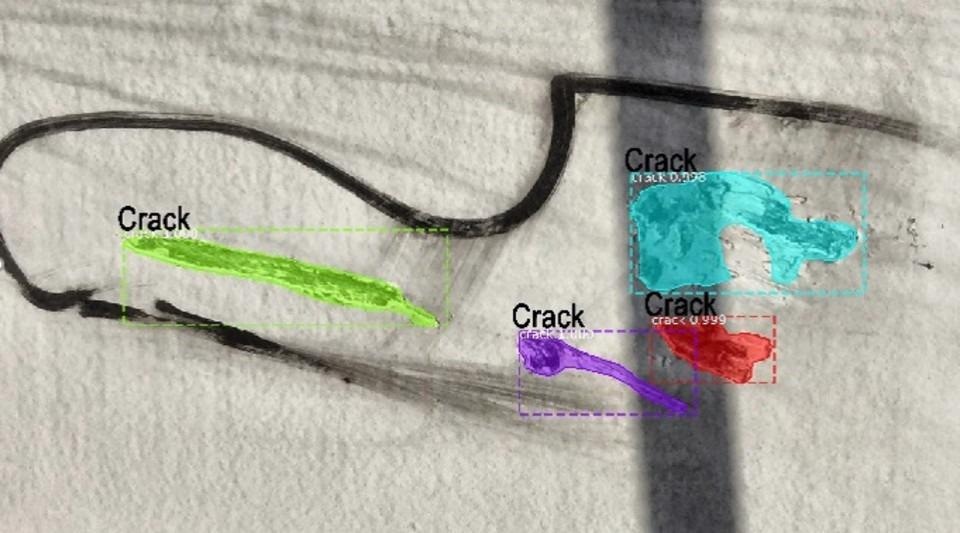Apr 1 2021
While the demand for wind power has increased considerably, the accompanying need to assess wind turbine blades and recognize flaws may have an impact on their operational efficiency.
 Crack detection using the AI tool. Image Credit: Loughborough University.
Crack detection using the AI tool. Image Credit: Loughborough University.
From ultrasound to visual thermography, a broad range of blade inspection methods have been tested, but these techniques have demonstrated certain limitations.
There are many inspection procedures that still need engineers to perform manual examinations in which a vast number of high resolution images are captured. Such analyses consume time and are affected by light conditions, and added to this, they are also dangerous.
Now, computer scientists from Loughborough University have designed a novel tool that utilizes artificial intelligence (AI) to inspect pictures of wind turbine blades to identify and highlight the defective areas.
The AI system has been 'trained' to classify defects by type, for example, void, erosion, crack and 'other,' which may result in quicker and more suitable responses. The system has received input and support from Railston & Co Ltd—a software solutions provider.
The recommended tool can now examine videos and images recorded from inspection processes performed with drones or manually. Upcoming studies will additionally explore the use of the AI tool with drones, aiming to prevent the requirement for manual inspections.
The AI system was trained by project leads Dr Georgina Cosma and PhD student Jiajun Zhang to identify different kinds of flaws using a dataset of 923 pictures recorded by Railston & Co Ltd, the industrial partner of the project.
The AI tool uses image enhancement and augmentation techniques, as well as AI algorithms (called the Mask R-CNN deep learning algorithm), to analyze the images. It then highlights the defective regions and tags them by type.
After designing the AI tool, the team tested it by feeding it with 223 new pictures. The recommended tool was able to achieve a test precision of about 85% for the task of detecting and categorizing the defects in wind turbine blades.
The results of the study have been published in an article titled “Image Enhanced Mask R-CNN: A Deep Learning Pipeline with New Evaluation Measures for Wind Turbine Blade Defect Detection and Classification,” in the Journal of Imaging.
The study has also recommended a new set of measures for assessing defect detection systems, which is urgently needed, specifically when AI-based defect detection and present-day systems are still emerging.
AI is a powerful tool for defect detection and analysis, whether the defects are on wind turbine blades or other surfaces. Using AI, we can automate the process of identifying and assessing damages, making better use of experts’ time and efforts.
Dr Georgina Cosma, Project Lead, Loughborough University
“Of course, to build AI models we need images that have been labelled by engineers, and Railston & Co ltd are providing such images and expertise, making this project feasible,” Dr Cosma added.
Defect detection is a challenging task for AI, since defects of the same type can vary in size and shape, and each image is captured in different conditions (e.g. light, shield, image temperature, etc.).
Jiajun Zhang, PhD Student, Loughborough University
Zhang continued, “The images are pre-processed to enhance the AI-based detection process and currently, we are working on increasing accuracy further by exploring improvements to pre-processing the images and extending the AI algorithm.”
According to Jason Watkins from Railston & Co Ltd, the company is “encouraged by the results from the team at Loughborough University.”
AI has the potential to transform the world of industrial inspection and maintenance. As well as classifying the type of damage we are planning to develop new algorithms that will better detect the severity of the damage as well as the size and its location in space. We hope this will translate into better cost forecasting for our clients.
Jason Watkins, Railston & Co Ltd
The experts from Loughborough University intend to find out how this technology can be utilized with drone inspections and have also planned to advance the study by training the system to identify the defect severity. The team is also hoping to assess the performance of the AI tool on other types of surfaces.
The study was financially supported by the EPSRC Centre for Doctoral Training in Embedded Intelligence, with industrial support from Railston & Co Ltd.
Journal Reference:
Zhang, J., et al. (2021) Image Enhanced Mask R-CNN: A Deep Learning Pipeline with New Evaluation Measures for Wind Turbine Blade Defect Detection and Classification. Journal of Imaging. doi.org/10.3390/jimaging7030046.